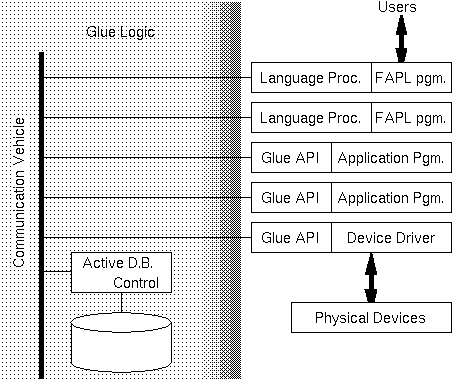![[Glue!]](/~ta113003/Glue/Logo.gif) Glue Logic Overview
Glue Logic Overview ![[Glue!]](/~ta113003/Glue/Logo.gif) Glue Logic Overview
Glue Logic Overview

The Glue Logic is used in a configuration shown in the figure above. In this figure, the shaded part represents the Glue Logic, and the boxes in the right half represents application processes which utilize the function of the Glue Logic.
The Glue Logic relays all inter-process communication among its application processes, and manages all data which are shared by those application process. Because of this, the Glue Logic can send the change notification messages, when the values of the shared data are altered. As the virtualizing the counterpart of the communication can be achieved by relaying all of the inter-process communincation, each application module can be independent from adding, deleting and alterling other modules.
The application modules can be expressed, using the Glue Logic API (Application Programming Interface) and a general purpose programming language, or using a global Factory Automation Programming Language (FAPL). Developing new programs using FAPL is easy, but to save existing software asset, users can convert old programs using the Glue Logic API. The development of the language processing system of the FAPL is scheduled after the development of the Glue Logic.
Currently, the design of the Glue Logic is based on the client-server model of transaction processing, as shown below.

The management of the shared data is done in a specific process running on the specific processor. All application processes comunicate only with this specific process.
As shown in the figure above, the Glue Logic consists of two major parts: the communication interface subsystem and the data management subsystem. The communication interface exchanges information with other processes running in both the same work-cell controller and remote work-cell controllers connected with the network system. The data management subsystem consists of also two parts: the data change monitor subsystem and the data storage subsystem. The data storage subsystem manages the association between the object name and its data provided by the client. The data change monitor subsystem moniters the changes in the data storage subsystem and sends the data change notification messages, and execute depending data evaluation.